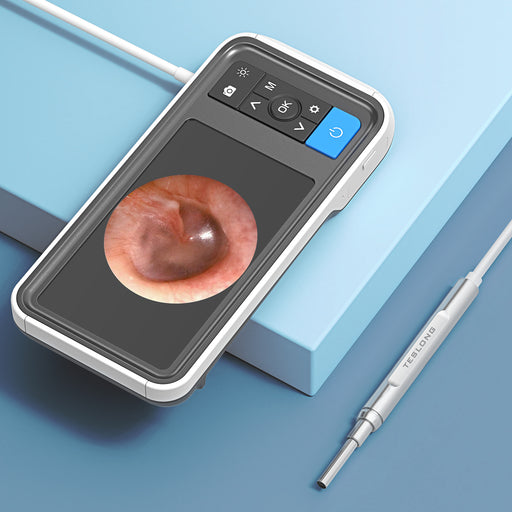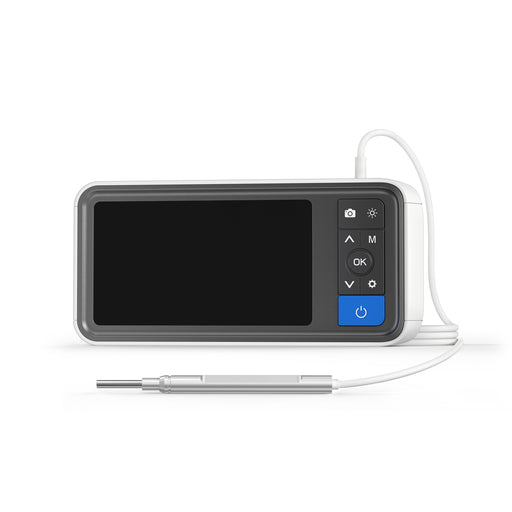FAQS
An otoscope is a device that allows the user to examine someone’s ear canal and eardrum, inside their nose, or the back of their throat. A traditional otoscope uses a light source and magnifying glass to let a physician see inside the patient’s ear, nose or throat during an examination.
Otoscopes range in price depending on the technology and size. You will be able to find basic USB otoscopes for as little as $20, while otoscopes used by doctors and professionals may cost thousands of dollars. As otoscopes that you use at home, stand-alone models with their own screen and batteries will cost about $100, while simpler WiFi and USB models cost less.
The best otoscope will depend on your needs – someone who wants to take better care of their health at home has very different needs to someone who plans to offer ear cleaning services professionally.
At Teslong, we can provide you with the best otoscope for easy home use. Whether you want a digital otoscope with a built-in screen, iPhone or Android compatibility, a USB otoscope or WiFi otoscope, we have an otoscope to suit you at a great price.
An otoscope is defined as an apparatus designed specifically for visual inspection of the outer ear, or ear canal, and the eardrum, as well as the back of the throat or nose using a light and magnifying lens. Modern digital otoscopes use an ear camera with a lens, which means users can see and take photos or video within their own ears, nose, or throat, and send those images to professionals who can better assess their health. In modern times, if someone refers to an otoscope, they likely mean a digital otoscope with a camera.
An otoscope can only damage your ear if it is misused. If not used carefully, the otoscope tip may irritate the ear canal lining, so you just need to make sure that you insert the otoscope steadily and slowly. If this irritation does occur, it is unlikely to be severe and will go away on its own.
The main risk comes if you insert the otoscope too far into the ear canal as there is a potential for damaging the eardrum. If you feel any kind of resistance, like something is blocking the canal, do not attempt to move the otoscope any further forward.
This is a good reason to use a digital otoscope, as you’ll be able to see whether you’re encountering a foreign object that needs to be removed or your eardrum.
Choosing an otoscope is easy, there are just a few factors you need to consider:
Size You need to select an otoscope that is a convenient size for your intended use. You can choose either a standard size or a pocket-size otoscope if you need something portable and convenient to carry around.
Power You will find that all of the digital otoscopes that we offer include rechargeable batteries so they are convenient to use, easy to charge and don’t have wasteful disposable batteries.
Light Since otoscopes are made to inspect inside dark places, like ears, they must include a light source near the lens to illuminate whatever they are pointed at. Historically, older designs have included filament light bulbs to illuminate the field of view, but these bulbs use lots of power and can get hot. All Teslong otoscopes use LED lights that are typically oriented in a ring pattern around the outside edge of the camera lens.
The quality of LEDs has improved vastly in recent years and is now much more efficient than filament bulbs. LEDs last up to several years without losing their brightness or efficacy and have a much longer battery life. Our LED lights also include a brightness adjuster, so that you are provided with the best possible image.
Probe/Head Size Possibly the most important consideration when choosing an otoscope is the size of the probe. Especially if you are going to be using your otoscope on infants or children, you want to be sure that the camera is small enough to fit comfortably in the ear canal without irritating the lining. Our otoscopes have super thin camera tips so that they can be used on people (and even pets!) of all ages.
Compatibility The final point you need to think about is compatibility. Do you want an otoscope that has a screen built-in or one that is compatible with your smart device?
An otoscope with its own screen will be at the higher end of the price bracket, so if you are looking for one that is a little more affordable you should choose an otoscope that is compatible with your computer or smart device, whether that be iOS or Android. We offer otoscopes that connect via USB, work with iPhones, or Android, so you can choose an otoscope to best suit your needs.
An otoscope can be inserted into the ear to view the ear canal up to the eardrum, which is the part of your ear that separates the external canal from the middle ear. The inner ear is behind the eardrum and so an otoscope cannot be used to view the inner ear.
Where an otoscope is used to inspect the ear, nose, and mouth, an ophthalmoscope is only used to examine the eye.
An ophthalmoscope uses the same principles as an otoscope, but shines a light through the pupil to view the back of the eye and allows trained professionals to perform an examination. Our otoscopes are not designed, or intended to be used, as ophthalmoscopes.
Often, looking after our own health, or that of our family and pets, is extremely difficult if it’s not somewhere you can easily see with the naked eye. An otoscope gives you the power to better assess an issue to see if you need to seek medical attention, or simply better care for yourself or your family. Our otoscopes are high quality and affordable, so browse our entire range today.
Digital otoscopes display the image on a screen of some sort, whether that be an included screen, desktop/laptop, iPhone, or Android phone, iPad, tablet, or some other device. Otoscopes with screens make it easier to see and diagnose problems. Conversely, ordinary traditional otoscopes have the doctor or user look directly into the patient's ear. They don't provide nearly as good of a view as a digital otoscope and rely on the doctor's eyesight. Digital otoscopes also allow the operator to see inside their own ear canal, something you cannot do with a traditional otoscope.
Now, digital otoscopes have a digital camera attached to the end of the device so users can see a high resolution image of the inner ear on a screen & record photos or video. This is much safer when working within the ear (such as during ear cleaning) because you can see what you’re doing better and avoid injuring the eardrum. A digital otoscope provides an easy way for anyone to stay on top of their ear, nose, or throat health and cleanliness.
A USB otoscope camera refers to an ear camera that connects to a smart device with a USB cable. USB otoscopes are compatible with Android phones, Windows PC, Chromebook, and MacBook. Keep in mind, USB does not work for iPhone, iPad, or Kindle Fire as they do not include a USB port. The smart device you connect to must include camera software and be plug-and-play compatible.
With a WiFi otoscope, you can link your otoscope to your smart device via WiFi. Most WiFi endoscopes will work with both Android and Apple devices, giving you more alternatives. Some even connect to laptops or televisions to allow for more options. Finally, the ability to connect to devices via WiFi enables more convenient recording and information access.
The images from an otoscope camera with a screen, or stand-alone otoscope, do not require a smart device to use. You won't need to find another device, download an app, or learn how to use the app because these devices have a dedicated screen. Stand-alone otoscopes also have their own batteries and memory card for photo and video storage.
A modern approach to earwax removal is to use a digital otoscope with a wax removal attachment. Teslong makes a number of devices that are safe to use because you can see inside your ear the entire time you are using the device. Digital otoscopes have integrated LED lights to illuminate the ear canal and give a perfect view of your eardrum.The soft silicone-tipped spoon attaches to the end of the otoscope and that combined with the camera gives you the perfect tool to scrape out pieces of earwax.
The No.1 cause of blurry images is ear wax getting stuck to the tip of the camera. Please use a cloth, alcohol pad, or a Q-tip to clean it off.
The best otoscope will depend on your needs – someone who wants to take better care of their health at home has very different needs to someone who plans to offer ear cleaning services professionally. At Teslong, we can provide you with the best otoscope for easy home use. Whether you want a digital otoscope with a built-in screen, iPhone or Android compatibility, a USB otoscope or WiFi otoscope, we have an otoscope to suit you at a great price.







